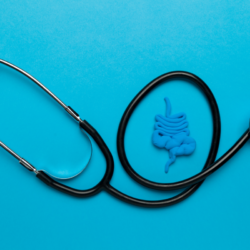Omega 6 (linoleic acid) and omega 3 (alpha-linolenic acid) polyunsaturated fatty acids are essential because our bodies cannot synthesise them. Omega 6 is found in certain vegetable oils, meat, fish, eggs, butter and cheese, while omega 3 is found in certain vegetable oils, oily fish, chia seeds, flax seeds and purslane. Omega 6 promotes inflammation and coagulation, while omega 3 is anti-inflammatory and protects the cardiovascular system. A balanced omega-6/omega-3 ratio of 4:1 is recommended, but Western diets often have much higher ratios, promoting inflammation and cardiovascular disease.
Omega 6(linoleic acid) and omega 3(alpha-linolenic acid) polyunsaturated fatty acids are essential; in other words, our bodies cannot manufacture them.
Omega 6 is found in certain vegetable oils (grapeseed, sunflower, safflower, sesame, wheat germ), meat, fish, eggs, butter and cheese.
Omega 3 is found in certain vegetable oils in the form of alpha-linolenic acid (camelina, rapeseed, linseed, hemp, walnuts, wheat germ), in certain fish in the form of EPA/DHA (mackerel, herring, sardines, salmon), and also in chia seeds, linseed and purslane.
What are these essential fatty acids used for?
The membrane of our cells is made up of a “double phospholipid layer” made up of two fatty acids: one saturated, the other unsaturated (omega 3). The quality of this cell membrane is fundamental in ensuring cell exchanges, facilitating cell flexibility and, of course, cell nutrition. Omega 3s ensure the integrity of cerebral functions, and their role in good cognitive functioning and concentration has been demonstrated. In fact, they ensure the proper transmission of nerve impulses.
During pregnancy, omega-3s play a role in the development of the foetus, which is unable to produce its own DHA. Omega 3s also have a role to play in the skin and skin Appendages.
Some studies show that they play a favourable role in preventing obesity.
Polyunsaturated fatty acids are precursors of prostaglandins, thromboxanes and leukotrienes, molecules whose function is similar to that of hormones. Omega 6 and 3 compete with each other in this function. Depending on their origin, these eicosanoids (molecules mentioned above) will have very different actions.
Omega 6 promotes vasoconstriction, platelet aggregation and blood clotting, as well as inflammatory reactions.
Omega 3s, on the other hand, are vasodilators, anti-thrombotic and anti-inflammatory. They protect the cardiovascular system.
It is estimated that in our Western diet, the ratio of omega 6 to omega 3 is between 10:1 and 30:1… a long way from physiological balance. This excess of omega 6 does not allow the body to use the little omega 3 it receives.
Are omega-6s good for your health?
Omega 6s play a crucial role in maintaining our health and ensuring that our bodies function properly. Here are the three main functions of omega 6:
Contribution to growth and development
Omega 6 fatty acids are essential for growth and development, particularly in children and adolescents.Linoleic acid (LA), a major type of omega 6, is a precursor of arachidonic acid (AA), which is vital for cell formation and maturation. These fatty acids contribute to the construction of cell membranes and are essential for the development of the brain and central nervous system. A deficiency in omega 6 during the first few years of life can lead to growth problems and developmental delays.
Function in the immune system
Omega 6s play a key role in the immune system.Arachidonic acid (AA), derived from linoleic acid, is an essential component of cell membranes and is involved in the production of prostaglandins, thromboxanes and leukotrienes. These molecules are involved in inflammatory and immune processes. Prostaglandins, for example, mediate inflammatory responses and regulate fever. Omega 6 therefore helps to modulate immune responses, protect against infection and promote wound healing.
Effects on skin and hair
Omega 6 has significant effects on the skin and hair. They contribute to the skin barrier and skin hydration.Linoleic acid helps maintain the skin’s elasticity and suppleness, preventing dryness and irritation. It is also crucial to hair health, promoting hair growth and preventing dryness of the scalp and hair. A deficiency in omega 6 can lead to dry, itchy skin and brittle hair.
What is the difference between omega 3 and omega 6?
Omega 3 and omega 6 are two types of essential polyunsaturated fatty acids, but they differ in their chemical structure, dietary sources and physiological roles.
Chemical structure
Omega-3s and omega-6s are distinguished mainly by the position of the first double bond in their carbon chain. For omega-3s, this double bond is located at the third carbon from the methyl end (-CH3) of the chain. In omega 6s, on the other hand, the first double bond is located at the sixth carbon. This structural difference influences their function and metabolism in the body.
Physiological roles of these fatty acids
Omega-3s and omega-6s play distinct roles in the body:
- Role of omega 3: Omega 3 is known for its anti-inflammatory properties.Eicosapentaenoic acid (EPA) and docosahexaenoic acid (DHA), two types of omega 3, are essential for cardiovascular health, brain development and function, and regulating inflammation.Alpha-linolenic acid (ALA), another type of omega 3, must be converted into EPA and DHA to be used effectively by the body.
- Role of omega 6: Omega 6 has pro-inflammatory properties and is necessary for growth and development, as well as for the functioning of the immune system.Linoleic acid (LA), the main omega 6, is converted into arachidonic acid (AA), which is a precursor of several important inflammatory mediators, such as prostaglandins and leukotrienes. These mediators play a crucial role in the immune response and tissue repair.
Should we eat as much omega 3 as omega 6?
The balance between omega 3 and omega 6 is crucial to good health. An excess of omega 6, particularly in relation to omega 3, can encourage chronic inflammatory conditions and be associated with cardiovascular disease, inflammatory disorders and metabolic problems. Ideally, the ratio of omega 6 to omega 3 should be close to 4:1 or less, although Western diets often tend towards a much higher ratio, sometimes 20:1 or more.
Common imbalance in modern diets
Modern diets are often characterised by a significant imbalance between omega 3 and omega 6, which can have significant consequences for health.
Causes of omega 3 / omega 6 imbalance
The imbalance between omega 3 and omega 6 in contemporary diets can be attributed to several key factors:
- High consumption of vegetable oils: Vegetable oils, such as corn oil, soya oil and sunflower oil, are rich in omega 6 and are widely used in processed products and culinary preparations. Their excessive use contributes to a disproportionate intake of omega 6.
- Processed foods: Processed foods and fast food often contain high quantities of vegetable oils rich in omega-6s, thus increasing the consumption of these fatty acids to the detriment of omega-3s.
- Reduced consumption of oily fish: Reduced consumption of oily fish, a primary source of omega-3s, also contributes to the imbalance. In addition, vegetarian and vegan diets may lack adequate sources of long-chain omega-3s (EPA and DHA).
- Modern farming and livestock rearing: Modern farming and livestock rearing practices, based on the use of omega-6-rich grains to feed livestock, increase the omega-6 content of animal products, thereby reducing the quality of the fats consumed.
- Lack of nutritional education: A lack of awareness and understanding of the importance of the balance between omega-3s and omega-6s leads to food choices that encourage imbalance.
Omega 3 deficiency = danger?
The imbalance between omega-3s and omega-6s in modern diets can have a number of negative impacts on health:
- Increased inflammatory conditions: An excess of omega 6 can promote inflammatory responses, increasing the risk of chronic inflammatory diseases such as arthritis, inflammatory bowel disease and other systemic inflammatory conditions.
- Increased risk of cardiovascular disease: Diets rich in omega 6, with a relative insufficiency of omega 3, are associated with an increased risk of cardiovascular disease. Excess omega 6 can promote platelet aggregation and vasoconstriction, thus contributing to atherosclerosis and cardiovascular events.
- Metabolic disorders: The imbalance between omega-3 and omega-6 can disrupt lipid metabolism, leading to insulin resistance, increased triglyceride levels and an increased risk of metabolic syndrome and type 2 diabetes.
- Effects on mental health: Omega 3 is essential for optimal brain function. A deficiency in omega 3, combined with an excess of omega 6, may be linked to an increased incidence of mental disorders, including depression, anxiety and mood disorders.
- Development of certain cancers: Although the data is still being validated, some studies suggest that an excess of omega 6 may promote the development and progression of certain cancers, in particular breast, prostate and colon cancer.
Food or supplements?
For naturopaths worthy of the name,health is first and foremost a matter of diet. In fact, recommending omega-3 supplementation can be a one-off tool for rebalancing the balance or can be useful in certain specific cases (particularly in the last trimester of pregnancy), but under no circumstances is it a lasting solution.
What are the 10 ways to follow an omega 3 cure?
- Eat foods rich in omega-3s, such as oily fish (salmon, tuna, sardines), nuts (cashew nuts, macadamia nuts, pecans), seeds (flax, chia) and seaweed.
- Take omega-3 food supplements, such as fish oil capsules.
- Add omega-3-rich oils to your dishes, such as flaxseed oil or hempseed oil.
- Incorporate fermented foods such as kimchi or miso into your diet, which contain omega 3s.
- Use sea products such as seaweed and kelp to flavour your dishes.
- Eat plant-based products such as chia seeds or ground linseed.
- Incorporate legumes and green vegetables into your diet, which contain plant-based omega-3s.
- Eat seafood such as mussels, scallops and oysters.
- Use vegetable oils such as rapeseed or walnut oil for cooking.
- Incorporate omega-3-rich foods into your smoothies and juices, such as flaxseed or cashew nuts.
So, in practical terms, how do you go about consuming these omegas on a daily basis?
As mentioned above, an over-abundance of omega-6s can lead to malabsorption of omega-3s. It is therefore crucial to reduce your intake of omega-6s, especially those from a diet of low nutritional quality. Fatty meats, milk-based fats, pastries, biscuits, pizzas, pies and industrial pastries should be eaten in moderation.
How can I consume omega-3 on a daily basis?
| Recommendation | Description |
|---|---|
| Consumption of omega-3-rich oils | 2 tablespoons a day of a first-press virgin oil rich in omega 3, raw and unheated (perilla, walnut, linseed, camelina). |
| Oleaginous fruit | A small handful of oleaginous fruits such as almonds, walnuts and hazelnuts every day. |
| Oily fish | 2 to 3 times a week, eat fresh or tinned oily fish, such as mackerel, herring, sardines or anchovies. |
| Ground linseed | Incorporate ground flaxseed into your daily diet. |
| Purslane | Eat purslane when it’s in season, as it’s a good source of plant-based omega-3s. |
This table summarises the essential recommendations for ensuring an adequate daily intake of omega-3s, promoting a good balance with omega-6s and contributing to better overall health.







